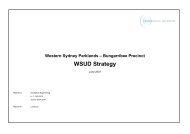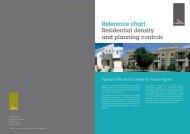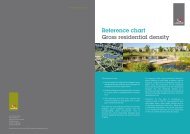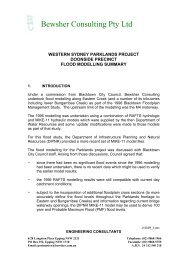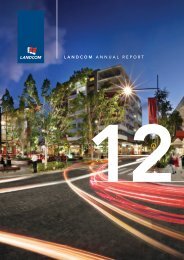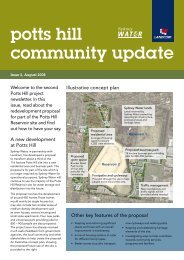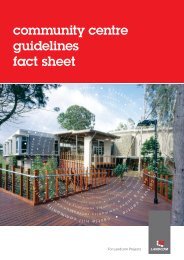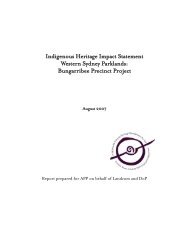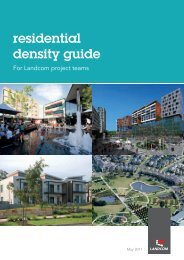Water Sensitive Urban Design
Book 2 | Planning and Management - WSUD
Book 2 | Planning and Management - WSUD
- No tags were found...
You also want an ePaper? Increase the reach of your titles
YUMPU automatically turns print PDFs into web optimized ePapers that Google loves.
<strong>Water</strong> <strong>Sensitive</strong> <strong>Urban</strong> <strong>Design</strong><br />
Figure 3b - Example of bioretention raingarden<br />
3.1.4 Sizing bioretention systems<br />
Figure 5 presents sizing curves for<br />
bioretention systems in Eastern and<br />
Western Sydney, showing typical<br />
performance for different catchment<br />
impervious fractions including 40, 60, 80<br />
and 100%. Different curves are provided<br />
for Eastern and Western Sydney to<br />
accommodate the influence of different<br />
rainfall patterns and volume on treatment<br />
performance. The sizing curves are<br />
presented in terms of the bioretention<br />
filter area as a percentage of the total<br />
catchment area.<br />
The curves assume that the bioretention<br />
system included 0.2m extended<br />
detention, 0.5m filter depth, and a<br />
sandy loam filter material, with<br />
a median particle size of 0.5mm<br />
and hydraulic conductivity of<br />
100mm/hr. It can be seen in Figure 5<br />
that in Western Sydney a bioretention<br />
system to treat a 40% impervious<br />
catchment can be sized at approximately<br />
1% of the catchment, whereas this<br />
increases to 1.5% in Eastern Sydney.<br />
For catchments with higher impervious<br />
fractions, a larger treatment area is<br />
required; at 100% impervious fraction,<br />
1.5% of the catchment is required in<br />
western Sydney and 2.1% in eastern<br />
Sydney.<br />
Other than the area, key aspects of<br />
bioretention system design that have a<br />
strong influence on pollutant removal<br />
performance include the extended<br />
detention depth, filter media depth<br />
and type of filter material. Bioretention<br />
performance improves with increasing<br />
depths of extended detention and the<br />
filter media, however deeper systems may<br />
not be feasible on all sites.<br />
16 Book 2 | planning and management



